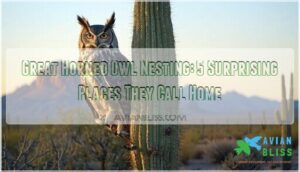This site is supported by our readers. We may earn a commission, at no cost to you, if you purchase through links.

These adaptable raptors don’t build their own nests—instead, they’re nature’s ultimate squatters, taking over abandoned hawk, crow, or squirrel nests in tall trees.
They’ll also claim tree cavities, rocky cliff ledges, and even old barns or building ledges in urban areas.
What makes them remarkable is their flexibility—you might spot them nesting 100 feet up in a desert saguaro cactus or just 10 feet high in a suburban park.
Their nesting season starts as early as February, when most birds are still planning their spring moves.
These strategic location choices reveal fascinating insights about their survival instincts and show how they thrive in various environments, making them a unique species to study, with their ability to adapt being a key factor in their success, and their ultimate squatters nature allowing them to make the most of available resources.
Table Of Contents
- Key Takeaways
- Nesting Site Varieties
- Takeover Behavior of Nests
- Tree Cavity Nesting
- Unconventional Nesting Locations
- Urban Nesting Adaptation
- Frequently Asked Questions (FAQs)
- What time of year do Great Horned Owls nest?
- Where do Great Horned Owls prefer to nest?
- Do owls nest in the same place every night?
- When do great horned owls lay eggs?
- How long is the fledgling period?
- What materials line the nest?
- How many eggs are typically in a clutch?
- What is the incubation period for eggs?
- When do great horned owls lay their eggs?
- How long do owlets stay with their parents?
- Conclusion
Key Takeaways
- You’ll find nests in diverse locations – Great horned owls don’t build their own nests but take over abandoned hawk, crow, or squirrel nests in trees, plus they’ll use cliff ledges, tree cavities, and even urban structures like barns and building ledges.
- They’re aggressive nest thieves – Up to 85% of their nests are stolen from other species through calculated takeovers, where they scout prime real estate during winter and forcibly evict the original builders just before breeding season.
- Winter nesting sets them apart – Unlike most birds, they start nesting as early as December through March, with peak activity in January-February, giving them a strategic advantage when other species aren’t actively breeding.
- Urban adaptation is remarkable – You’ll spot them thriving in cities on skyscrapers, bridges, and cell towers, proving they can successfully nest within blocks of busy streets despite challenges like light and noise pollution.
Nesting Site Varieties
Most Great Horned Owls don’t bother with construction work—they’re excellent at finding ready-made homes instead. You’ll discover these adaptable birds in surprisingly diverse owl nest locations, from abandoned hawk nests sixty feet up in towering oaks to cozy tree cavities just fifteen feet off the ground.
Their nest site selection depends heavily on geographic variation. In eastern forests, they’ll commandeer old crow nests in beech and maple trees, while western populations prefer cliff ledges and canyon walls.
Geographic variation shapes where these master home-invaders choose to set up shop.
Nest height varies dramatically based on available options, though they consistently choose spots that can support three to four pounds of owl family. The nest materials they inherit—sticks, bark, and feathers—gradually deteriorate throughout the season.
These practical birds rarely practice site reuse, since most nests fall apart after one breeding cycle. They’re particularly drawn to locations with open canopy nearby, which provides better hunting access and allows parents to spot potential threats.
This flexible owl nesting behavior explains their remarkable success across diverse habitats, from northern Canada’s boreal forests to tropical mangroves. To guarantee safety, owls often consider distance from food when selecting a nesting location.
Takeover Behavior of Nests
While observing these remarkable predators, you’ll discover their nest acquisition strategies are far more cunning than expected. Aggressive takeovers represent their most notorious owl nesting behavior, with up to 85% of nests originally built by other species.
Why build when you can steal? Great Horned Owls are the ultimate real estate pirates of the bird world.
This species displacement isn’t accidental—it’s calculated resource competition. Nest reuse through takeover occurs when Great Horned Owls identify prime real estate already constructed by hawks, crows, or herons.
Their owl and hawk interactions often result in complete displacement of the original builders. The timing coincides perfectly with late winter territorial disputes, giving owls first dibs on prime owl nest locations. Such behavior is a form of bird behavior territorial defense.
Here’s how these owl nest takeover scenarios typically unfold:
- Surveillance Phase: Owls scout occupied nests during winter months, noting which structures offer the best protection and access
- Strategic Strike: Using superior size and aggression, they forcibly evict current occupants just before breeding season peaks
- Immediate Occupation: Within days of takeover, owls begin nesting preparations, adding their own materials to stolen architecture
This kleptoparasitic behavior showcases their adaptability—why build when you can simply commandeer?
Tree Cavity Nesting
While owls don’t construct their own homes, tree cavities offer prime real estate for nesting pairs.
These natural hollows in mature cottonwoods, oaks, and pines provide excellent protection from predators and harsh weather.
Cavity size matters – owls need spaces at least 16 inches wide and 8-24 inches deep to accommodate their growing family.
Cavity competition with squirrels and woodpeckers means early occupation by late January gives pairs the best advantage.
Unlike platform nests, cavities rarely contain internal lining, relying instead on debris from previous inhabitants for cushioning their eggs.
These cavities are often created by primary excavator species like woodpeckers.
Unconventional Nesting Locations
Beyond tree cavities, these adaptable raptors choose surprising unconventional nesting locations that’ll amaze you.
Their flexibility helps them thrive across diverse habitats when traditional options aren’t available.
Here are four remarkable unconventional nesting sites:
- Cliffside Nests: Rocky cliff ledges and canyon walls provide excellent vantage points, though they’re exposed to harsh weather conditions.
- Ground Nests: Rarely used but documented in areas lacking suitable trees, typically in dense vegetation or sheltered depressions.
- Building Ledges: Abandoned structures, barns, and silos offer secure platforms that mimic natural cliff environments.
- Artificial Platforms: Human-made nest boxes, machinery platforms, and utility structures serve as modern nesting sites.
These unusual cavities and manmade structures demonstrate remarkable nesting habits. Some birds even use spider webs for weaving their nests. Whether it’s cliff ledges or abandoned buildings, Great Horned Owls prove they’re masters of adaptation, finding safe nesting sites wherever opportunity presents itself.
Urban Nesting Adaptation
You’ll find great horned owl adaptability shines brightest in cities, where they’ve mastered urban nesting on skyscrapers, bridges, and cell towers.
City Owl Survival depends on their Human Proximity Tolerance, letting them nest within blocks of busy streets and construction sites. Urban Prey Abundance from rodents and small mammals supports thriving populations in metropolitan areas.
However, Light Pollution Impact disrupts their natural hunting rhythms, forcing behavioral adjustments. Artificial Nesting platforms and nest boxes help offset habitat loss, while park systems provide essential green corridors.
Urban owl habitat creates unique challenges—noise pollution affects communication between mates, yet these adaptable predators continue expanding into city centers. Their nesting sites now include stadium lights, hospital rooftops, and university campuses, proving remarkable resilience in concrete jungles.
They’re considered adaptable to habitats, including forests, swamps, and even deserts.
Frequently Asked Questions (FAQs)
What time of year do Great Horned Owls nest?
When winter blankets the land like a protective embrace, you’ll discover these fierce hunters breaking nature’s conventional rules.
Great Horned Owls begin their nesting season in winter, typically starting December through March, with peak activity occurring January through February.
Where do Great Horned Owls prefer to nest?
You’ll spot these magnificent predators choosing abandoned hawk, crow, or heron nests high in mature trees, typically 15-60 feet up.
They also favor tree cavities, cliff ledges, and occasionally urban structures that mimic natural sites.
Do owls nest in the same place every night?
Owls don’t typically roost in the same exact spot nightly.
They’ll rotate between several favorite perches within their territory, choosing spots that offer safety, shelter, and good hunting access based on weather conditions and prey availability.
This behavior is driven by the need for shelter and good hunting access.
When do great horned owls lay eggs?
You’ll discover Great Horned Owls don’t follow typical bird schedules—they actually lay eggs during winter’s harshest months, typically from December through late March, with peak activity in February.
How long is the fledgling period?
Great Horned Owl fledglings leave their nest at approximately 40 days old but remain dependent on their parents for several more months.
They achieve short flight capabilities by seven weeks and develop full flying skills around 9-10 weeks of age, which marks a significant milestone in their development as they become more independent.
What materials line the nest?
A bird in the hand is worth two in the bush,"
and you’ll find Great Horned Owl nests lined with bark, feathers, fur, and leaves that deteriorate to bare sticks by season’s end.
How many eggs are typically in a clutch?
You’ll typically find two to four eggs in a Great Horned Owl‘s clutch, with three being most common.
The female lays these large, white eggs over several days during winter months, usually starting in December through March.
What is the incubation period for eggs?
Great horned owl eggs incubate for approximately one month before hatching.
You’ll find the female doing most of the incubation work while her mate roosts nearby, providing food and protection throughout this critical period.
When do great horned owls lay their eggs?
Like clockwork in nature’s calendar, you’ll find these magnificent hunters laying eggs from December through late March.
Southern populations start earlier, while northern owls begin their winter nesting journey in the harshest months, ensuring their young are ready to face the challenges of their environment, and this timing is crucial for their survival.
How long do owlets stay with their parents?
You’ll find that owlets stay with their parents for an extended period, remaining dependent through summer and into early fall.
Parents provide hunting instruction and feeding for several months after fledging.
Conclusion
Remarkably, these absolutely incredible adaptors have mastered great horned owl nesting across virtually every North American habitat.
You’ll find them thriving in locations ranging from towering forest canopies to bustling city centers, demonstrating their exceptional flexibility.
Their opportunistic approach to claiming existing structures, whether natural tree cavities or human-made platforms, showcases remarkable survival intelligence.
Understanding these nesting patterns helps you appreciate how great horned owls successfully maintain stable populations despite habitat changes, making them one of nature’s most successful residential strategists with stable populations.
- https://www.allaboutbirds.org/guide/Great_Horned_Owl/lifehistory
- https://txtbba.tamu.edu/species-accounts/great-horned-owl/
- https://digitalcommons.usf.edu/cgi/viewcontent.cgi?article=2685&context=jrr
- https://sora.unm.edu/sites/default/files/journals/jfo/v070n04/p0535-p0542.pdf
- https://www.owlresearchinstitute.org/copy-of-great-horned-owl





